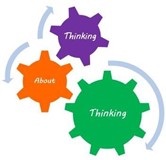
Maeve Quinn of The Douay Martyrs Catholic Secondary School uncovers the crucial aspects of metacognition and how they can be applied to any educational environment, to improve the ways learners monitor and purposefully direct their learning.

For my SENDCO award in 2021, I was given the task to consider the intended impact of strategic change in my school in relation to Special Educational Needs. Being relatively new to the school setting, it was a huge challenge to not only collect data, undergo research but also to choose a specific area of change to a well-oiled machine. As an educator of 20+ years’ experience, and due to the limiting nature of Covid, I decided to focus on the cohort of pupils I was teaching. Being particularly passionate about self-directed learning, I had successfully taught the fundamentals of Carol Dweck’s Growth Mindset to a year 3 class in a primary setting. The pupils began embedding the well taught phrases into their everyday learning and parental comments were very positive, as they noticed how their beliefs in and around learning were slowly changing into a more positive excitable experience.
As part of my research, I completed extensive reading and the study of Metacognition particularly interested me. It was popping up more and more on educational platforms it was becoming the new buzzword in terms of pupil ownership of their learning. Henceforth, I made the decision to build on my Growth Mindset success by delving deeper into metacognition and how these skills could be combined and transferred to a secondary setting. Unwittingly, I realised that I had been teaching metacognitive strategies as part of my Growth Mindset approach to learning. It made sense therefore, to make this the focus for my research.
As a definition, ‘Meta’ is a term that means ‘referring to itself.’ In other words, students must learn how to learn. They must be reflective about their growth. They must learn to set goals, select strategies, and evaluate their progress. They must internalise a growth mindset, believing effort matters and approach challenges with excitement.
Alongside this, metacognition is about the ways learners monitor and purposefully direct their learning. Wilson argues that “Teaching students to become more metacognitive equips them with skills to “drive their brains” and become self-directed learners” (Wilson, 2016, p. 2). Therefore, for pupils to ‘drive their brains,’ strategies need to be taught to equip them with skills to become ‘self-directed learners.’ So, metacognition directs their learning and in order to become ‘self- directed’ they need to self-regulate their own learning. Consequently, metacognition and self-regulation are likely bedfellows.
During my research, I uncovered the crucial aspects of metacognition and how they can be applied to any educational environment. I have had to reteach myself and discover how I was learning to create impact in the classroom. The fundamental word when it comes to metacognition is ‘How.’ I call it the ‘How’ factor. Reframing thoughts is essential. Instead of I don’t know how to do this say How can I do this? For me it was simple case of writing the problem I needed to solve and writing a list of achievable steps of how I would achieve this. This led to a breakdown of essential steps that we can use as educators to help students embrace learning, be excited about solving problems and learn important life skills.

Figure 1: Metacognition Matrix (Quinn, M. 2022)
Practical Solutions
It is necessary therefore to teach explicit metacognitive skills and improve self- regulated learning for pupils to make progress. Since the challenge is to teach students to consciously monitor and regulate their cognition, they should first consciously think about it, and choose to set a goal. We can remind students that learning isn’t something that just happens, and it doesn’t happen the same way for all of us all the time. By watching how we’re learning, making note of our struggles, strengths, and patterns, we can actually become better learners. If a student fails a Maths problem, for example, it may be valuable to talk about how thinking processes, attitudes, motivation, and context may have played a role in how they chose their method of problem solving.
Delving deeper into the research has enabled me to uncover a series of practical solutions that can be taught and embedded in the classroom in a timely manner. The most recent research by the Education Endowment Foundation EEF (Sharples et al, 2020) sets out metacognition and self-regulated learning as part of its Teaching and Learning Toolkit. The seven step recommendations (See figure 2) set out a roadmap for teaching of metacognition and self-regulated learning in the classroom which is a clear-cut tool for the busy modern teacher.

Figure 2: Summary of recommendations for metacognition and self-regulated learning. Education Endowment Foundation (EEF: Sharples et al., 2019)
The empirical research that the EEF has completed is “an accessible overview of existing research with clear, actionable guidance” (Sharples et al. Dec 19). This guidance prompted some practical solutions that can be adapted to any setting. The areas identified are:
1. CPD for teachers to develop their understanding of metacognition and how to implement it in the classroom. Building on the Growth Mindset (Dweck, 2017) approach and turning I can’t into I can is a starting point to begin the dialogue around positive approaches to learning. Wilson talks about “practical optimism” (Wilson, 2016, p. 42) and the importance of having an optimistic mindset to nurture self-belief and positivity before learning takes place. In summary, if they know the reasons why they don’t want to learn and can find positive strategies to change, then obstacles to learning dissolve.
2. Teach pupils how to plan, reflect and evaluate their learning. Once the motivational strategies have been taught, pupils then need to be explicitly taught strategies on how to learn. These must be modelled by the teacher and can include tasks such as links to prior learning, independent practice and “structured reflection” (Sharples et al., 2020). Verbalising out loud what thought processes are going on in our brains is a powerful way of directing learning. It shows the students that solving problems need to be talked through and broken down into achievable steps. The I do, we do, you do model springs to mind here.

Figure 3: Evidenced Based Teaching (Killian, S. 2016)
This can also include metacognition strategies for teachers (See Figure 4) which can be taught and displayed. Providing pupils with their own metacognition strategies (See Figure 5) helps embed the practice in a classroom where daily metacognitive talk around learning is used. I have laminated these for use in lessons as a prompt to pupils who need to reframe their thoughts around learning. I have also discovered that reading through these steps with the pupil can calm an anxious child and is also a good self-regulation strategy.

Figure 4: Metacognition strategies for teachers (Quinn, M. 2021) Adapted from Hamilton’s ‘Hacking Questions’ (Hamilton, 2021)

Figure 5: Metacognition strategies for pupils (Quinn, M. 2021) Adapted from Hamilton’s ‘Hacking Questions’ (Hamilton, 2021)
3. Challenge is age and ability-appropriate: The importance of an appropriate level of challenge cannot be underestimated, whether it’s extending learning for high achieving pupils or pitching to the SEND learner. The practice of this learning could be in the form of “Retrieval Practice” (Jones, 2019) style questions such as picture prompts and quizzes to use as pit stop activities during a lesson, to engage the pupils and promote enjoyment of the learning process. The teacher working alongside the pupil can have a regular dialogue about how the learning is progressing and make a professional judgement on moving the learning forward.
I was also curious about how the pupils felt about their own learning. Were they aware of how they learn? Were they using approaches that worked for them that they could share with others? To satisfy my curiosity, I created a questionnaire framing specific questions around metacognition and motivational learning. The results revealed that they lacked the skills to self-motivate their thoughts before they begin their learning so motivational strategies are crucial.
The promise of comfort breaks work wonders and can be a key motivational factor. Alongside this, quick, pacy fun activities that involve a competitive nature excite the pupils and hugely increase engagement. Interestingly, 92% agreed with the statement ‘Every day is a new opportunity for me to get better and improve’ and ‘I like learning new things, even if I make mistakes.’ The opportunity to build on this optimism is pivotal in addressing their attitude to learning. However, the need for metacognitive strategies to ‘self-direct’ their learning will be a crucial first step in the learning journey for these pupils.
From the research, we can see that the ability to drive learning for pupils involves a process of empowering them with positive approaches to learning and strategies that they can use independently to become confident learners. After all, “What lies behind us and what lies before us are tiny matters compared to what lies within us” (Oliver Wendell Jones).
